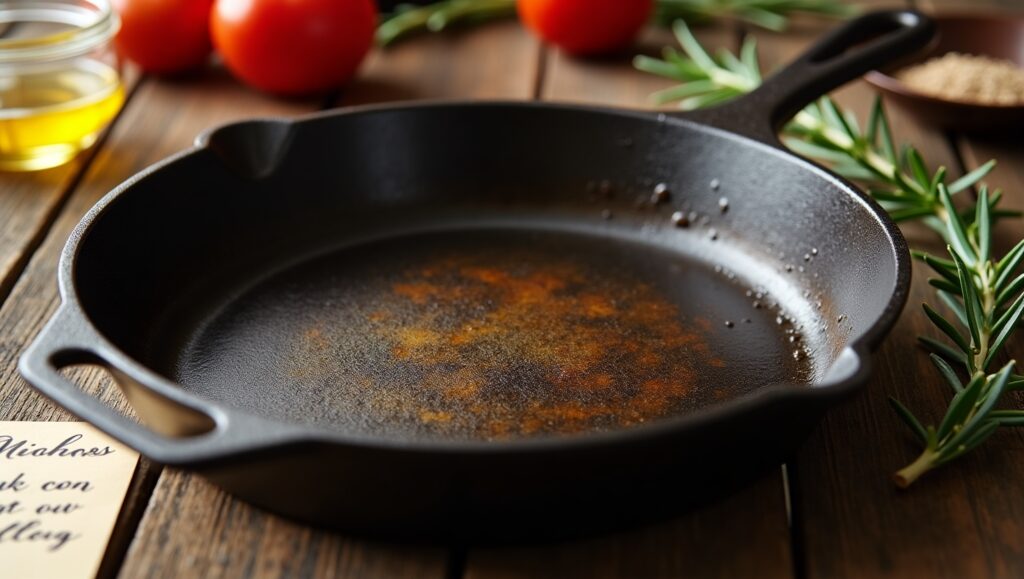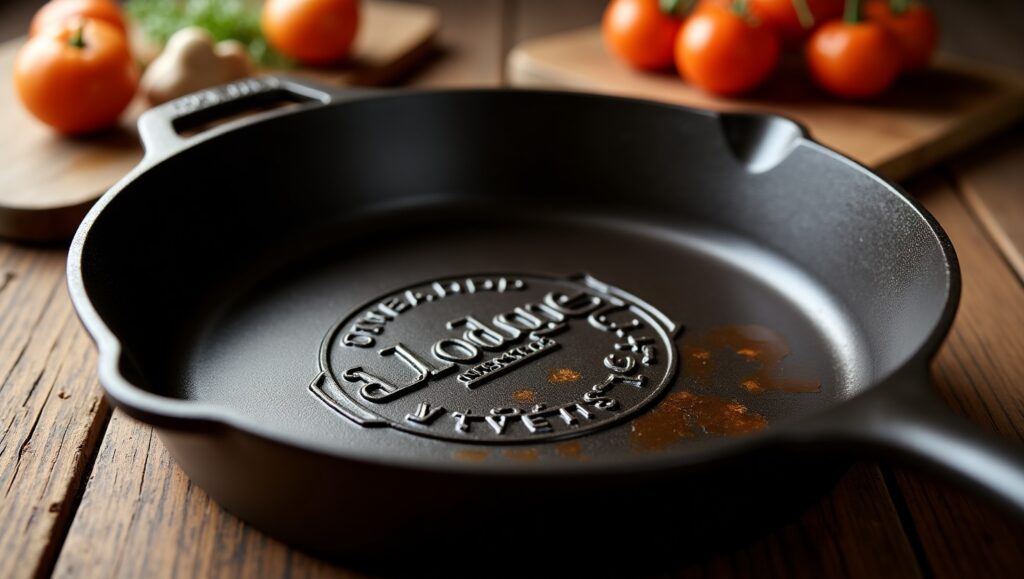The secret to achieving such potential out of your cast iron skillet is seasoning. Whether frying bacon or searing a great steak, a well-seasoned cast iron unit has the potential to provide a truly non-stick surface, outstanding toughness, and really good heat retention. This all-encompassing guide will take you through all of the details that you need to know when seasoning cast iron, including selecting the best oil and step-by-step techniques to apply in developing the best coating. This is an essential read, as far as making your cast iron cookware last a lifetime, and improving the more you use it.
What Is Cast Iron and What Is the Reason for Its Popularity?
Cast iron is hundreds of years old in the kitchen, valued as a superior retainer of heat and as an all-purpose cookware. Be it skillets, dutch ovens, or grill pans, cast iron cookware is adaptable enough to be used on a gas stove, in the oven, or even on a campfire. The most important thing about cast iron is that it is so durable that it can, in fact, survive generations with proper care.
This carbon and iron combination may wear out due to rust unless properly taken care of, and the seasoning process will have the effect of forming a covering, which guards the cast iron against moisture and food particles. This is all the more reason why you need to know how to season and care for your cast iron skillet.
Cast Iron Cookware Seasoning: What Does it Mean?
Seasoning your cast iron pan is simply coating the pan lightly with cooking oil and baking it at a high heat to produce a hard, non-stick surface. This layer is created once the oil polymerizes, i.e., becomes a slippery, plastic-like film, which sticks to the metal.
This seasoning layer gets better as you continue to use it, particularly when you are cooking bacon, frying in other oils with a very high smoke point. Periodic re-seasoning will help to maintain and renovate a well-seasoned pan, but constant use will continue to build up a good seasoned cooking tool.
The Reason Why You Need to Season Your Skillet Regularly

Seasoning your cast iron skillet regularly can do more than increase its performance; it also lets you take care of your investment. Seasoning prevents oxidation of various iron and steel parts on your skillet from rust.
Seasoning also leads to non-stick cooking, so your cast iron can be as versatile as the non-stick cooking pans with unhealthy coatings. When you season your skillet, you not only make it friendly to clean, safe to use, but also to do whatever comes in between searing and sauteeing.
Here is how to season a cast iron skillet:
Step 1: Pan Cleaning
The first thing you should do is clean your cast iron pan in soapy water (the first time, it is allowed to use some soap). Clean it thoroughly with a rough brush or steel wool, and get off any factory coating or old seasoning. Clean it up completely dry.
Step 2: Oil Apply
Then put a little amount of oil on the pan, approximately one scarf of oil — either Crisco, canola oil, or flaxseed oil. Ensure that you cover all by putting some onto all over, including the inside, the handle, as well as the bottom. And do make sure to remove any surplus oil — you merely want to have a thin coating.
Step 3: Bake it
Put the pan on its head into the oven at about 450–500°F. Be sure to use a layer of foil at the bottom as a drip catcher. Having baked it for an hour, leave it to cool in the oven. It is here that the oil polymerises and the magic takes place.
Step 4: Repetition
A repeat performance of seasoning may be carried out 2 to 3 times for optimum results. This adds an even stronger and more efficient layer of seasoning that can withstand a daily cooking effort.
Which oil to use to season a cast iron pan?
Not every oil is the same. The ideal oil to season with should have a high smoke point since it may not burn in the process. The frequent options are:
- Canola oil
- Vegetable oil
- Flaxseed oil
- Crisco
- Lard
- Seed oil
Whereas others will swear by using flax seed oil in some of their top-coating finishing, which are longer-lasting and more persistent, the vegetable oil and canola oil are the most available and preferable to beginners. Regardless of the oil you are using, make sure at all times you are applying thin coats so as not to make it too sticky.
Is there a Way to use the Stove Top?

Although the oven gives very even heat surrounding the skillet, it is normal to find some folks heating the pan over the stove before seasoning it. In order to do this:
- Heat the frying pan on medium fire.
- Apply some cooking oil or any non-stick food in a thin layer to the cooking surface using a paper towel.
- Heat the pan and have the oil smoke a little.
- Repeat it 2-3 times.
It is effective to use this approach when you need just a slight touch-up or do not scorch the entire kitchen by heating it.
The Actual Way of Cleaning a Cast Iron Skillet without Removing the Seasoning
You are to follow these tips to clean a cast iron skillet without destroying the layer of seasoning:
- Do not soak in water.
- It should not be put in the dishwasher.
- Gently scrub with hot water and use a stiff brush.
- Leave off the soap, unless you are going to re-season.
- They should be thoroughly dried and the surface coated with a thin oil layer.
Never wash the pan when it is hot; it will warp. Properly taking care of your cast iron would ensure that your seasoning is preserved.
And what happens in case Your Cast Iron Begins to Rust?
There is no need to panic in case your cast iron gets a bit rusty because it has fixable options. Clean the rust using steel wool or a scrub pad. Rinse in soapy water, thoroughly dry, and go through the seasoning procedure once more.
When you add oil when it is hot, it will then assist in keeping that cover intact. However, when the damage goes deep, you may be required to scrape off the seasoning altogether and start fresh.
What is Lodge Cast Iron? Is it pre-seasoned and ready to use?

Yes! Lodge cast iron cookware is pre-seasoned and thus can be put to use immediately out of the box. Nevertheless, most of the fans continue to add another production of cooking oil and run them through the oven twice, and bake them to perform better.
This applies to cast iron cookware using Lodge skillets or grill pans; anything you use can be seasoned to your preferences for cooking and choice of oil.
Old-seasoning a Cast Iron Skillet: How to cook with an old-seasoned cast-iron pan.
When you have stickiness on the skillet, discoloration, and some flaky buildup, you need to re-season. Here’s how:
- Clean the old seasoning with steel wool.
- Cleanse and wipe it dry.
- Put a thin cover of oil and roast (turned upside down) in the oven.
- Re-do it 2-3 times.
This will give a new, clean environment that works like new. Cast iron should be used over time to ensure the seasoning keeps improving on its own.
Important messages: Ways to Perfectly Season Cast Iron
- Cast iron should be seasoned to stop it from rusting and also get a non-stick finish.
- Oils that have a high smoke point, such as canola, vegetable, or flaxseed oil, should be used.
- Apply and brush a thin coating of oil and bake upside down in the oven for 1 hour.
- Clean the pan using very little water; never use any soap, unless you need to re-season it.
- Re-season when the old seasoning flakes or is sticky.
- The Lodge cast iron is already seasoned; however, several more rounds will make it better.
- Frying in your skillet, cooking bacon, and other regular use assists in preserving and adding seasoning.
- Make sure you have not forgotten to cool, paint a new layer of oil, and put them in a dry place.
And since you now understand how to season your cast iron, your cast iron skillets are now set to serve you over the next few decades. New or old cast iron, just do this and your cookware will return the favor by searing and browning everything perfectly.
Frequently Asked Questions (FAQ)
Q1. What is the principle of seasoning cast iron?
A1: Seasoning can be carried out by coating a thin film of oil on the surface of the cast iron, followed by the heating of the oil to its smoke point. This makes the oil polymerize, a chemical action that makes the oil a hard, slippery compound that sticks to the metal. The outcome is a non-stick, rust-free surface that, when used, becomes better every time. The same protective coating can provide the pan with the signature black sheen and assist in deterring food sticking as well.
Q2. What is the point of seasoning a cast-iron pan?
A2: Cast iron pans should be seasoned because there are a number of reasons:
- It is a non-stick cooking surface that does not use dangerous chemicals.
- It guards your cast iron against rust and against moisture.
- It will add taste to your food as well as wear out the pan for a better performance.
Whether you have bought new cast iron or revamped an old skillet, with the right seasoning, you can make your cast iron pans last generation after generation.
Q3. How does one season cast iron for the first time?
A3: There are only a few basic steps to seasoning a cast iron pan (particularly an unseasoned one) the first time (or clearing off the old rusty coating):
- Clean and scrub the pan with soapy water to remove any substances of any form, like residue or wax covering.
- Thoroughly dry and grease the pan with some oil; there is a wide variety of oils that are recommended, many recommending vegetable oil, canola oil, or flaxseed oil.
- Put the pan upside down in an oven to bake at 450–500°F for one hour.
- Leave it to cool in the oven and go through the same process once again to make the seasoning layer stronger.
Q4. What is the best way to season a cast iron skillet?
A4: The most effective seasoning procedure in a cast iron skillet is:
- Apply cooking oil (Crisco, vegetable, or canola oil) with a paper towel in a thin layer.
- It is put upside down in the oven so that excess oil does not pool.
- High-heat baking (450 to 500°F) 60 minutes.
- Cool inside the oven and do the process 2-3 times to give the final durability of the finish.
This way of seasoning gives a robust, polished surface, which is perfect for cooking pretty much anything, including eggs and steak.
Q5. What temperature should I season cast iron at, 350 or 450?
A5: Seasoning at 350 degrees may be a workable option, but the better course of action would be 450 degrees. High smoke point oils (such as canola or flaxseed oil) require more heat to adequately polymerize. The seasoning of the facility at 450°F is more effective and gives a stronger and more solid coating. But remember not to put too much oil on, which would stick together too much, and remember to allow the pan to cool down slowly after heating.




